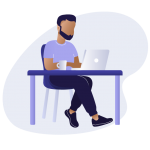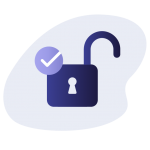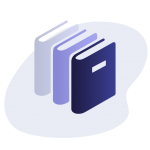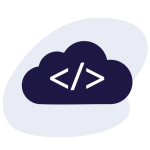Every semester brings unexpected twists, but this one has been historic. Our hearts go out to all of you who have navigated the many disruptions of spring 2020.
The closure of our buildings was a disruption we certainly didn’t expect, but in March that’s where we found ourselves. We knew without question that the transition to remote learning would be disruptive, despite the best efforts of the University’s administration and faculty. With a focus on our mission to support student success, we asked ourselves what we could do to soften the blow. Here’s a behind-the-scenes look at what that transition has looked like for us.
1. Doubled down on how we connect with people.

Chat and email reference have long been available, but those numbers picked up quickly: From March 18 to the end of the semester, we answered upwards of 2,400 questions via chat, remote consultation, email and virtual office hours. We’re here for you whether you’re an instructor, a student or none of the above; whether you prefer phone, Zoom or email; whether you need to consult with Music Library staff, troubleshoot your podcast with the Media Resources Center, find archival photos for your documentary project or visualize your research data with help from the Research Hub. We’re still real people helping you in real time. Hit us up!
2. Boosted access to electronic resources.

During this crisis, many vendors have temporarily increased access to some of their online resources — including the HathiTrust Emergency Temporary Access Service, World Scientific Journals, African American Historical Serials Collection and expanded access to Kanopy streaming video. Our catalogers have also prioritized the addition of online resources to the catalog, including eBooks, streaming video and non-English-language open access journals. From scientific e-journals to bingeable documentaries, we’re working hard to increase access to the content you need.
3. Crossed “return books” off your list of things to worry about.

There’s enough uncertainty right now without having to stress about library due dates. All items due on or after February 12, 2020, were renewed en masse through August 31, 2020, and any associated overdue fines have been waived for these items. (You can check to see what’s checked out to you here with your Onyen and password.)
4. Moved instruction online.

Library class instruction sessions shifted online, through a combination of live Zoom sessions and learning objects created by librarians. So did our software workshops such as R Open Labs, Introduction to EndNote and Introduction to F1000 Workspace. The Media Resources Center’s online tutorials, via this guide, supported people working on audio and video editing at home. (Get in touch if you’re interested in the MRC’s hour-long media online production instruction sessions!)
5. Found electronic replacements for print resources.

If you left for spring break without your course materials, you were not alone. As the University prepared to transition to remote instruction, we worked with instructors to make course reserve materials available electronically. That meant scanning hundreds of pages for reserves as we were on our way out the door, and finding electronic replacements for hundreds more. The move to remote instruction meant adding 450 additional electronic items to electronic reserves (articles, book chapters, etc.), plus 121 links to streaming films. All told, library e-reserves supported about 12,000 students for the full semester. (Instructors, more on reserves here.)
6. Made high-powered software available remotely.

If you rely on the software at the Davis Library Research Hub computer lab, the sudden lack of access may have been daunting. Our librarians updated their Virtual Computing Lab (VCL) image, called DAVIS LIBRARY RESEARCH HUB Esri Microsoft. The image offers access to Microsoft Office, ArcGIS (ArcMap), ArcGIS Pro and Kumo for easy access to files on OneDrive. (For details, see our GIS Software page.)
7. Created a digital version of our student-curated spring exhibition.

At the start of spring break, students in Dr. Katherine Turk’s honors American history course, Women in the History of UNC-Chapel Hill, were working with librarians, preparing to mount an exhibition called “Climbing the Hill: Women in the History of UNC” in the Wilson Special Collections Library. With the building closed, we’ve worked with the class to embrace an online-only exhibition.
8. Donated supplies to protect our health care workers.

Like most members of our community, we’ve been eager to support health care workers on the front lines of the pandemic. At the beginning of April, the makerspace at the Kenan Science Library leveraged its suite of equipment as part of a volunteer effort to produce face shields for doctors and nurses treating COVID-19 patients. We also donated personal protective equipment typically used in our operations, including gloves, N95 masks, goggles and disinfectant, to UNC Hospitals.
9. Continued to plan for the long term.

In addition to all the unexpected work, we’re continuing to do what we’ve always done. That includes acquiring materials and making them available to you — now with an eye on a future that may include more remote instruction. We’re improving our catalog by adding vernacular script to our Urdu, Hebrew and Persian materials; adding Cyrillic data to Slavic titles; and expanding access to Latin American language materials. And we have accessibility projects underway, transcribing digitized videos and adding alt-text to digitized photographs for more universal and searchable access to special collections materials.
10. Prepared to document the moment.

We are all living through history, and it is our mission in the Library to preserve a record of Carolina’s past. As we work through this difficult period, we invite all members of the University community to share their experiences of life during the COVID-19 pandemic, to be preserved as a part of the permanent collections of the University Archives at Wilson Library. (For more on how to participate, see this blog post.)
There’s no way around it: This semester has been difficult. We’ve been inspired to see all of you working so hard in the face of unforeseen hardships, and proud to support you in any way we can. If there’s anything you need, please let us know. We’re here for you — then, now and in the future.
Story by Emily Jack. Illustrations by Aleah Howell.


